Article and all photos by Joe Mock, BaseballParks.com
All rights reserved
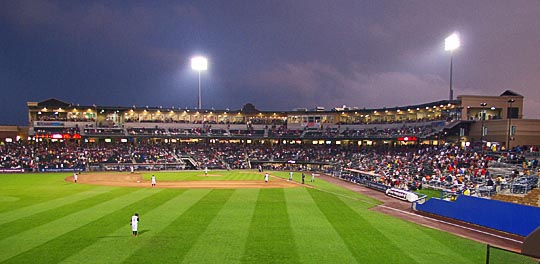 |
One of the first things you’ll notice when you enter Coca-Cola Park is that the “pig” theme is carried throughout the facility. It’s not done in a pig-headed way, though. It’s light-hearted and in good taste, and you’re bound to chuckle at some of the cute ways the team uses pig-related terms. Yes, you’ll even find some messages written in Pig Latin.
| Ballpark Stats |
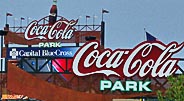 |
| Team: The Lehigh Valley IronPigs of the International League |
| First game: April 11, 2008, a 6-0 loss to Richmond |
| Capacity: 10,000, including 8,101 fixed seats |
| Architect: HOK |
| Price: $48.4 million |
| Home dugout: Third base side |
| Field points: Northeast |
| Playing surface: natural grass |
| Betcha didn’t know: The area had been without affiliated Minor League ball since 1960, when the Allentown Red Sox played in the Eastern League |
But one thing you would never say about the ballpark is that it is a pigsty.
Coca-Cola Park is the lovely home of International League baseball in the Lehigh Valley of Pennsylvania. In much the same way as the Montreal Expos escaped poor attendance and an apathetic government to become the Washington Nationals, the Ottawa Lynx migrated south to the Keystone State and became the IronPigs. Unlike the Nationals who had to endure three seasons at a sub-par facility while waiting for their new playground to be designed and constructed in D.C., the Lynx were able to move right into this shiny new (pig) palace without having to settle for a temporary pigpen for a season or two.
The ballpark didn’t come easily — it was built on a site designated as a “brownfield” by the Environmental Protection Agency — or cheaply, as the total pricetag was nearly $50 million. But as you would imagine, the locals have embraced it, as the IronPigs’ attendance figures have been exceeded only by perennial leaders Louisville and Buffalo in the 14-team International League … this despite the fact that the IronPigs, well, aren’t very good. In fact, they lost their first 11 games of the 2008 season, included a 6-0 shutout loss to the Richmond Braves in the park’s Opening Night.
Before we begin to wallow in the details of the ballpark, let me explain the team’s nickname.
As you might know, raw iron ore is melted down in order to create steel, and Bethlehem, PA produced much of the steel used in construction projects across our country. The melted iron is called “pig iron” because, according to the team’s website, it was poured into molds that “resemble a row of piglets.” The nickname IronPigs stuck not only because it is cute, unique and pays homage to the major industry of the area, it also provides great merchandising potential.
And the team went hog wild employing “pig” and “iron” puns all around the ballpark. Here is a partial list: the team’s mascots are pigs FeRROUS and FeFe (the symbol for iron on the periodic table is Fe); the game program is called Pork Illustrated; the bar and grill in right field is called the Trough; the eatery down the first base line is the Blast Furnace Grill; the one behind third base is the Lunch Pail; the one behind section 102 is the Iron Grill, the food stand in the season-ticket-holder lounge upstairs is Hog Heaven; a sit-down area with made-to-order food is called the Pig Stop; the hog-shaped receptacle where fans can make donations to the team’s charity is called the IronPiggy Bank; and perhaps most importantly, the best ballpark food item I’ve encountered this entire season is the Nacho Porker (more later).
The Setting
Coca-Cola Park is in a light industrial area between Allentown and Bethlehem. The location does provide sufficient space for parking lots, but the two- and three-lane roads leading to those lots do back up before and after games.
For the most part, you approach the stadium from beyond left field. That’s because there is nothing — no parking, no streets, no commerce — behind the third-base side of the ballpark, which is unusual. This also means that the main entry plaza isn’t behind home plate, like at most parks. Instead, it’s near the right-field foul pole (which is actually beyond the right-hand edge of the shot below).
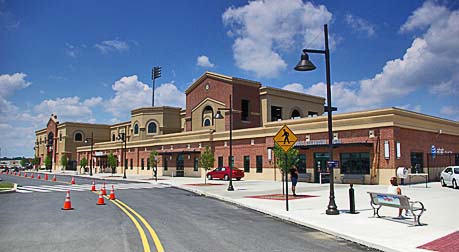 |
As far as I could tell, there are no restaurants, hotels or shopping of any kind within walking distance of the facility itself. Given the nature of the surrounding roads and businesses, I doubt any such commerce ever will be located next to the park.
The park is not in an inconvenient area, as it is located not far from an exit of U.S. Route 22, a main east-west thoroughfare through the valley. It’s also near the area’s airport. Its immediate surroundings, though, aren’t very noteworthy.
What is noteworthy, though, is that this land was designated a “brownfield” by the EPA, as mentioned above. That meant that the soil possibly had contamination left behind by years of manufacturing electronics components on this site. Usually, this means an expensive clean-up, possibly even the meticulous cleaning of the soil itself, as happened in D.C. However, through a rare process of obtaining “insurance” from the EPA, Allentown was able to insure the cost of remediation (if it had been necessary) up to $1 million. This permitted construction of the park to commence. It was only the second time in U.S. history that the EPA permitted the use of the “Brownfield Revolving Loan Fund” monies to purchase such insurance under these circumstances.
The Exterior
Continuing the trend of recent years, there is only a limited use of brick in the exterior of Lehigh Valley’s ballpark. Brick is featured around the entryway behind home plate (below left) and around the structure that houses the souvenir store, which is open even when there is no game going on. Otherwise, the exterior building material is a natural colored concrete or block.
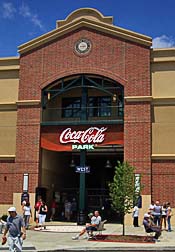 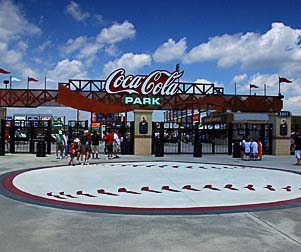 |
As mentioned above, the entryway that is used by the majority of fans isn’t part of the main structure of the park. Instead, it’s well down the first-base line, meaning you enter fairly close to the right-field foul pole. That entryway (above right) features a fairly large plaza outside of the gates, with a baseball painted on the concrete. Inside the gates is another large gathering area.
The Design
Things get even more interesting on the inside of Coca-Cola Park.
One aspect of the park’s design that works, but is probably going to be lost on the majority of fans who attend games here, is that there are sub-themes at work. Unlike, say, the ballparks in Brooklyn (amusement park) or North Little Rock (train station), there isn’t an overall theme being followed. Instead, different portions of Coca-Cola Park are meant to have the feel or look of different parts of the Lehigh Valley.
Martin DiNitto, Associate Principal at HOK, told me that “the exposed steel structure of the stadium and the right field outfield concourse advertising structure (are) recalling the history of steel production in the area.” Of course, Bethlehem was one of our country’s foremost steel producers, and you see the steel ad structures in the photo on the left side below. Further, “The left field concourse preserves a view corridor outside the stadium and distant pastoral views,” thereby resembling “the rolling, agricultural landscape outside the urban areas.” Hence the reason behind there being no road or parking lots behind the third-base side of the park.
Finally, DiNitto said that “the exterior of the ballpark reflects a lot of the architectural context of Allentown,” which is why there is such a traditional — almost row-house — look to it, including bay windows.
Clever people those architects!
 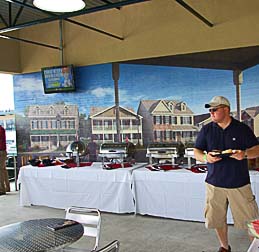 |
If you know to look for this, it makes the experience of attending a game at Coca-Cola Park even more pleasant. As I said, though, these attempts at tying in design concepts to the “look” of local areas is too subtle for the average fan — or almost any fan — to notice. In fact, when I asked a front-office employee of the IronPigs about these themes within the ballpark, he told me he had no idea what I was talking about.
Unmistakable, though, are the picturesque murals of a local neighborhood on the walls of the party decks (above right) at the ends of the upper level.
A very welcome structural feature of the ballpark is the use of open spaces from the concourse to the outside world (below left). Not only does it have the obvious benefit of adding more natural light, it also provides needed air circulation to help the main seating bowl stay more comfortable on hot days. The main concourse itself is quite wide and comfortable.
  |
The seating bowl was modeled after recent Major League parks, complete with a separate section of seats called the Dugout Suites directly behind the backstop. These seats, which can be seen toward the left side of the right-hand shot above, are for the well-heeled fans, as they cost $40 apiece when purchased in a block of 30 seats. Of course, access to an actual “suite” with air conditioning is part of the deal, as there are four directly behind the seats.
This area of the ballpark can be accessed only by taking an elevator down to the ground level and passing by or through a special concession area that is just for these fans. Once in your seat, you’ll have an unparalleled view of the action (below left). Sections like this are also in the new big-league parks in Philadelphia, St. Louis and Washington, and in the remodeled Dodger Stadium.
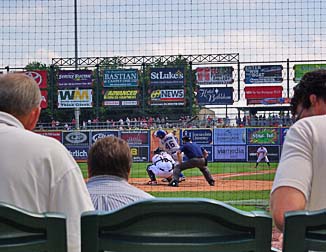 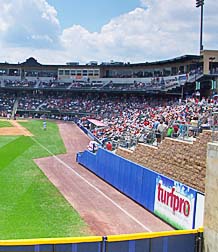 |
For the most part, the views of the field from all seating sections are more than adequate. One thing is that is not adequate, though, is the amount of foul territory near the foul poles. Unfortunately, this is another new-ballpark trend, and it’s not a good one. As you can see above, an outfielder has extremely little room between the foul line and the wall. When more of the warning track is in fair territory than foul near the foul poles, then I think you’re inviting injuries.